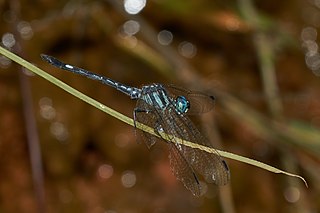
The macaques constitute a genus (Macaca) of gregarious Old World monkeys of the subfamily Cercopithecinae. The 23 species of macaques inhabit ranges throughout Asia, North Africa, and Europe. Macaques are principally frugivorous, although their diet also includes seeds, leaves, flowers, and tree bark. Some species such as the long-tailed macaque will supplement their diets with small amounts of meat from shellfish, insects, and small mammals. On average, a southern pig-tailed macaque in Malaysia eats about 70 large rats each year. All macaque social groups are arranged around dominant matriarchs.

Gomortega keule is a species of tree endemic to Chile. It is the sole species of the genus Gomortega and, according to the APG IV system of 2016, of the monotypic family Gomortegaceae, assigned to the order Laurales in the clade magnoliids.
A near-threatened species is a species which has been categorized as "Near Threatened" (NT) by the International Union for Conservation of Nature (IUCN) as that may be vulnerable to endangerment in the near future, but it does not currently qualify for the threatened status.

An IUCN Red List Critically Endangered species is one that has been categorized by the International Union for Conservation of Nature as facing an extremely high risk of extinction in the wild. As of December 2023, of the 157,190 species currently on the IUCN Red List, 9,760 of those are listed as Critically Endangered, with 1,302 being possibly extinct and 67 possibly extinct in the wild.

Loxococcus rupicola is a species of palm tree, and the only species in the genus Loxococcus. It is endemic to Sri Lanka. It is threatened by habitat loss.

Villa's gray shrew is a shrew native to northeastern Mexico, where it is called musaraña.

The Boano monarch, or black-chinned monarch, is a species of bird in the family Monarchidae endemic to Indonesia. It is found on Boano island in the southern Mollucas. Its natural habitats are subtropical or tropical moist lowland forest and subtropical or tropical moist shrubland. It is threatened by habitat loss.

The Biak monarch, or Biak monarch flycatcher, is a species of bird in the family Monarchidae. It is endemic to Biak Island, Indonesia.

The Kolombangara monarch, or Brown's monarch, is a species of bird in the family Monarchidae. It is endemic to Solomon Islands. Its natural habitat is subtropical or tropical moist lowland forests. It is threatened by habitat loss.
The Tanahjampea monarch or white-tipped monarch is a species of bird in the family Monarchidae. The scientific name commemorates British colonial administrator and zoological collector Alfred Hart Everett.

The Kai monarch, or white-tailed monarch, is a species of bird in the family Monarchidae. It is endemic to the Kai Islands. Its natural habitat is subtropical or tropical moist lowland forests. It is threatened by habitat loss.
The Mussau monarch, also known as the white-breasted monarch, is a species of bird in the family Monarchidae. It is endemic to the Bismarck Archipelago of Papua New Guinea. Its natural habitats are subtropical or tropical moist lowland forests and rural gardens. It is threatened by habitat loss.

The Somali hedgehog is a species of mammal in the family Erinaceidae. It is endemic to Somalia and Somaliland. The Somali hedgehog is nocturnal.

Hylaeothemis is a genus of dragonflies in the family Libellulidae.

A vulnerable species is a species which has been categorized by the International Union for Conservation of Nature as being threatened with extinction unless the circumstances that are threatening its survival and reproduction improve.

The Flores monarch is a species of bird in the family Monarchidae. It is endemic to the western half of the island of Flores in Indonesia.

Hylaeothemis apicalis, the blue hawklet, is a species of dragonfly in the family Libellulidae, endemic to India.
The bluebelly Java snake, also known commonly as Fruhstorfer's mountain snake and the Javan bluebelly snake, is a species of snake in the family Colubridae. The species, which is the only member of the genus Tetralepis, is endemic to Java.














